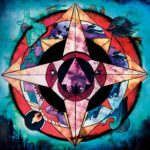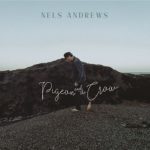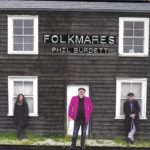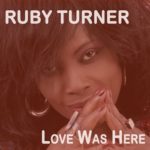 This album is like a sea-breeze on a hot summer’s day; it’s cooling and soothing, and once it starts, you don’t want it to stop. Canadian Maya Rae isn’t eighteen yet and she’s already been singing professionally for six years. Six years! She recorded her first album of jazz covers at the age of thirteen, but this is an entirely different beast; it’s a batch of songs co-written with her brother Evan that display a remarkable maturity while still retaining a sense of wonder and innocence. They’re delivered by a set of highly-accomplished musicians, and the end of result is my favourite new album of the year so far. If your interest has been piqued by what you’ve read so far, check out some of the Spotify song links as well. If you want a few quick and easy reference points, try early Joni Mitchell, Norah Jones and maybe even (completely coincidentally) the first Corinne Bailey Rae album.
This album is like a sea-breeze on a hot summer’s day; it’s cooling and soothing, and once it starts, you don’t want it to stop. Canadian Maya Rae isn’t eighteen yet and she’s already been singing professionally for six years. Six years! She recorded her first album of jazz covers at the age of thirteen, but this is an entirely different beast; it’s a batch of songs co-written with her brother Evan that display a remarkable maturity while still retaining a sense of wonder and innocence. They’re delivered by a set of highly-accomplished musicians, and the end of result is my favourite new album of the year so far. If your interest has been piqued by what you’ve read so far, check out some of the Spotify song links as well. If you want a few quick and easy reference points, try early Joni Mitchell, Norah Jones and maybe even (completely coincidentally) the first Corinne Bailey Rae album.
You would expect someone who’s been singing professionally since the age of twelve to have a good voice and you won’t be disappointed. Maya’s voice is rich and clear, and she has an impressive range as well. We all know that often that isn’t enough; you need the right team and usually you need a good throw of the dice at some point.
This album came about as a result of Maya sending a demo to Canadian uber-producer Steve Dawson, who managed to pull a bunch of musicians together in Nashville to record the album in just three days. The result sounds anything but rushed; it all fits into place perfectly and the arrangements create the perfect picture-frame for all of the delicately-crafted songs. And there are so many insidious hooks. Whether they’re the work of Steve Dawson or the musicians involved in the project, I don’t know, but each one pulls you in to the song, and they come from all directions, violin, guitar, organ, synthesiser; you name it.
I recommend that you give the entire album a listen, but if you twisted my arm, my favourites would be the incredibly catchy opener “Can You See Me”, which talks about the masks we wear to hide our true selves, the optimistic “The Sun Will Come Out Again” and the sinuously funky, Bill Withers-esque, groove of “New to Me”. I could go on, but I really want you to listen to the whole album and then buy it. This classy bunch of songs, beautifully interpreted, and sung with such clarity and precision, is something your collection needs.
“Can You See Me?” is out now on Black Hen Records (BHCD0092).
 It’s time for the third Danberrys (Dorothy Daniel and Ben DeBerry) album, “Shine”. The Nashville duo has taken four years over this piece and it’s a marked departure from their more acoustic Americana sound. Just a quick look at the album credits tells you, in addition to the usual guitar, mandolin and even pump organ, there’s another palette of sounds created by the addition of trombone, tuba, vibes, drums and percussion, the last three contributed by co-producer Marco Giovino. The innovative way percussion is used throughout the album is a clear indication of the involvement of drummer on the production team. The instrument tally on the album is impressive, but they’re used sparingly in a minimal and stark production. And let’s not forget the superb vocals, harmonies and counterpoint.
It’s time for the third Danberrys (Dorothy Daniel and Ben DeBerry) album, “Shine”. The Nashville duo has taken four years over this piece and it’s a marked departure from their more acoustic Americana sound. Just a quick look at the album credits tells you, in addition to the usual guitar, mandolin and even pump organ, there’s another palette of sounds created by the addition of trombone, tuba, vibes, drums and percussion, the last three contributed by co-producer Marco Giovino. The innovative way percussion is used throughout the album is a clear indication of the involvement of drummer on the production team. The instrument tally on the album is impressive, but they’re used sparingly in a minimal and stark production. And let’s not forget the superb vocals, harmonies and counterpoint.
The album’s opener “Shine” sets the tone, building from a sparse primal rhythm to a brooding, supernatural mantra. The message is that we have to continue to shine a light to penetrate the darkness that surrounds us. There’s a melancholy thread that runs through the album although the message is ultimately one of hope; from “Shine” and the simple, folky “Love Conquers War” which references the protest movement and hammers the message home with the final line, ‘We shall overcome’, and the uplifting exhortation to self-belief of the Bo-Diddley-inflected “The Mountain”. The variety of the arrangements means that there aren’t too many reference points, although “Undertow” does hint at Fleetwood Mac.
The lyrics are interesting; they’re very subtle and they’re more about pointing you in a certain direction and allowing you to make your own interpretation. Although there are repeated references to darkness and dying, the album ultimately feels like a positive experience.
“Shine” is a compelling and haunting set of songs with innovative arrangements which holds your attention throughout with its stark intensity.
And here’s a bit of trivia for you. The person playing guitar, trombone and tuba is Neal Pawley, trombone player with Southside Johnny and the Asbury Jukes and Southside’s Americana project, The Poor Fools.
“Shine” is released in the UK on Friday May 8th on Singular Records.
 It’s heart-breaking to see so many press releases at the moment that tell that a band or artist will be touring to support their new album. This stuff is planned months ahead, and longer, to coincide with the album coming out. The press release for “Blue Sky” refers to band touring through 2020 to promote the album; even with Trump’s best bluster, that’s unlikely to happen now, so one of the few things to do is look out for the good reviews and make sure that you get them out there. But I’m sure that The Reverend Shawn Amos will have that under control, because of his background in digital marketing (among other things). Ok, here’s another one for you.
It’s heart-breaking to see so many press releases at the moment that tell that a band or artist will be touring to support their new album. This stuff is planned months ahead, and longer, to coincide with the album coming out. The press release for “Blue Sky” refers to band touring through 2020 to promote the album; even with Trump’s best bluster, that’s unlikely to happen now, so one of the few things to do is look out for the good reviews and make sure that you get them out there. But I’m sure that The Reverend Shawn Amos will have that under control, because of his background in digital marketing (among other things). Ok, here’s another one for you.
In a career that’s been characterised by fairly dramatic shifts, “Blue Sky” is no exception. After embracing the broad church of blues, Shawn Amos had very little interest in writing; he wanted to sing and play harmonica. Things changed, however, after his move to Texas from California and a long-term commitment to The Brotherhood (Brady Blade – drums, Christopher Thomas – bass, and Chris ‘Doctor’ Roberts – guitar); he’s also totally committed to writing now as well as performing.
The album’s opening song, “Stranger Than Today”, feels like a bridge between California and Texas. The styling is pure West Coast (synthetic beats aside) although the subject matter is pure blues; the life and death of Little Walter, blues harmonica innovator. And from there on in, it’s blues in its many hues, from the heartbreak blues of “Her Letter” through the New Orleans, gospel settings of “The Job is Never Done” to the straightforward jump blues of “27 Dollars”, harking back to KC Douglas’ “Mercury Blues”, with the theme of buying a Coupe De Ville at all costs. Other highlights include the uptempo rock of “Hold Back”, hinting at the driving Seventies sound of Bob Seger and the Silver Bullet Band and the album’s closing song “Keep the Faith, Have Some Fun”, which is simply structured, but throws in everything, including Latin horns and gospel call and response vocals.
“Blue Sky” covers most of the blues spectrum from dark, swampy Southern blues to uptempo horn-driven Latin-tinged blues. It’s a collection of great players working together to make great music with a strong political agenda, led by a charismatic and committed frontman. Give it a listen.
“Blue Sky” is out in the UK now on Put Together Music (PTM-00008).
 If you want reference points for “Pigeon and the Crow”, I’d go for something between “Sweet Baby James” and “Graceland”. It has the simple, laid-back feel of James Taylor and the experimental rhythms and instrumentation of Paul Simon’s classic. There’s a lot going on, but it never feels cluttered or claustrophobic. There’s something that sets this album apart from the two classics, and it’s the lyrical invention of Nels Andrews’ songs, which are mostly allegorical and metaphorical rather than following straight-line narratives and it makes for a very interesting mixture. It’s a compulsive and beguiling set of songs. And before we move away from the comparisons, you could say that there are hints of Jackson Browne, and Nels’ voice at times sounds a lot like Ian (or Iain) Matthews at the time he was trying to crack the American market in the seventies.
If you want reference points for “Pigeon and the Crow”, I’d go for something between “Sweet Baby James” and “Graceland”. It has the simple, laid-back feel of James Taylor and the experimental rhythms and instrumentation of Paul Simon’s classic. There’s a lot going on, but it never feels cluttered or claustrophobic. There’s something that sets this album apart from the two classics, and it’s the lyrical invention of Nels Andrews’ songs, which are mostly allegorical and metaphorical rather than following straight-line narratives and it makes for a very interesting mixture. It’s a compulsive and beguiling set of songs. And before we move away from the comparisons, you could say that there are hints of Jackson Browne, and Nels’ voice at times sounds a lot like Ian (or Iain) Matthews at the time he was trying to crack the American market in the seventies.
The press pack for the album contains a lyric sheet for the album (it’s in the album packaging as well), but also a very helpful set of writer’s notes for each song, which share the sort of detail you would never pick up on otherwise. “The Lion’s Jaws” is based on the story of an in-law who, at one time, was the only Jewish lion-tamer in history, which is an interesting coincidence, given that Scottish singer-songwriter Dean Owens (recently reviewed here) has also written about a not-too-distant ancestor who was a lion-tamer.
To get some idea of the musical variety of the album, you only need to take a look at the credits. There are thirteen musicians involved and a list of fourteen instruments (not including the many under the umbrella of percussion) from various musical traditions including kora, steel pan, harmonium and flute; it’s not just a lot of instruments, it’s a lot of musical styles melding together seamlessly by producer, flautist and singer Nuala Kennedy.
Highlights? The title song’s hard to beat, with its supernatural love story theme and its lilting Gaelic feel; the opener “Scrimshaw” in triple time and with mid-life memories of happiness and regrets is a perfect evocation of the singer-songwriter genre, and the slightly rockier “Table by the Kitchen” is a fiddle-led, fear-of-missing-out anthem satirising the me generation. What remains in the memory when you reach the end of the album, is the sheer variety of musical settings used to project these songs and support Nels’ mellifluous voice and the way that none of it seems out of place.
“Pigeon and the Crow” is out now.
 Phil Burdett; the eternal iconoclast. The most characteristic line of the album for me is ‘antagonize a purist’ from the album’s closing song “Newport Electrics”. The song, and the message, are built around Dylan’s infamous electric performance at the Newport Folk Festival in 1965, although the intro hints at the Hendrix performance of “The Star-Spangled Banner”. It doesn’t actually typify the album; it’s twice as long as most of the songs and three times longer than some and it has a psychedelic, hippy-trippy vibe with Indian percussion and hints of Ravi Shankar’s influence. You can fill your boots checking out the Dylan references, but there’s more buried there in the story of how music constantly evolves in the line ‘the strummer’s fix is in’ – is it the frontman of The Clash or a general reference to three chords and the truth guitar players? You decide.
Phil Burdett; the eternal iconoclast. The most characteristic line of the album for me is ‘antagonize a purist’ from the album’s closing song “Newport Electrics”. The song, and the message, are built around Dylan’s infamous electric performance at the Newport Folk Festival in 1965, although the intro hints at the Hendrix performance of “The Star-Spangled Banner”. It doesn’t actually typify the album; it’s twice as long as most of the songs and three times longer than some and it has a psychedelic, hippy-trippy vibe with Indian percussion and hints of Ravi Shankar’s influence. You can fill your boots checking out the Dylan references, but there’s more buried there in the story of how music constantly evolves in the line ‘the strummer’s fix is in’ – is it the frontman of The Clash or a general reference to three chords and the truth guitar players? You decide.
As always with Phil Burdett albums, you can spend all the time you have unpicking the words and looking for the references. I’m not doing it for you, but I’m just saying it might be worthwhile. Phil will argue that lyrics aren’t poetry because they rely on the music to make them work, but let’s just say they’re written in a poetic style. We can probably agree on that.
“Folkmares” came out of a difficult time for Phil; he has a work ethic that won’t allow him to stop. If he can’t write songs, he’ll paint or write poems or find some other way of creating art. What’s certain is that it won’t be boring or bland: guaranteed.
It’s a home studio recording with Phil singing, playing guitars, keys, bass, percussion and harmonica, while Steve Stott (fiddle and mandolin) and Colleen McCarthy (vocals) supply the folkier elements and a more country, string band sound. Phil’s influences are many and varied and most of them poke their heads over the parapet at some point in the album’s fifteen (yep, fifteen) songs. It’s a nod to the folk tradition that almost a third of the songs on the album are in 3/4 time, and those are some of the most poignant songs. I bet you want to know what some of the songs are about as well.
The album looks back to an earlier time in Phil’s life, not through the rose-tinted sunglasses of nostalgia, but the telephoto lens of realism, with absolutely no filters. The songs are set in either central London (Soho, Camden, you get the picture) and south-east Essex (Basildon and Canvey). The London settings have the feel of a Patrick Hamilton novel fifty years on at the start of the Thatcher era (looking forward as well in “Albion Caustic”), with scenes in pubs and an interesting array of characters. There aren’t too many happy endings either.
The Essex songs are set in a slightly earlier and maybe more innocent period, shining a bit of light on a time of life where everything seems possible yet impossible at the same time. We’ll start there for favourites. “New Factory Hand” (in ¾ time) evokes with concise phrases the stark reality of working life in the late sixties and early seventies and how we escaped from it, while the song following, “From a Van on the Coryton Road” is set just before the Thatcher era capturing the drudgery of dead-end jobs around Canvey Island and again the escape, ‘When Friday rolled by we would lead our wage packets to drink’.
I’ve already mentioned “Newport Electrics” a very personal take on the history and hypocrisy (bit of Jane Austen there, sorry) of the folk scene while “The Last March” does the same for the march and demo movement of the mid-eighties and the ‘I was there’ pose. You could update it for 2020 and call it “The Last Petition”. While we’re with the stupid ideas, the busker’s anthem “Flatpicking Sorrows on Borrowed Guitars” could be filmed by Wim Wenders as “The Busker’s Hatred of Brown-Eyed Girl”. Just sayin’.
What else? The packaging of course. Phil likes to include a lyric booklet and this time the photography (by Steve Stott and Rob Shaw) and the design, layout and graphics (by Steve Stott) combine to create a perfect setting for the lyrics. Bloody good job all round, I say from the Southend massive and a namecheck for John Bulley because I don’t want to leave him out.
While we’re all going stir-crazy, why don’t you treat yourself to a big helping of lyrics that will actually make your brain work and some really interesting musical settings.
“Folkmares” is out now and it’s available here. You won’t spend a better tenner before the lockdown ends.
Bit of a video taster before you go? Thought so:
 Twenty albums in twenty years; that’s not bad going, particularly when you have a day job fronting up for Jools Holland’s Rhythm and Blues Orchestra. You probably know that Ruby Turner has a fabulous voice, but she’s much more than the chanteuse with Jools Holland; Ruby Turner is a genuine British soul phenomenon with a career stretching back into the mid-eighties and some astonishing live and recorded performances (if you haven’t already heard it, check out her version of “Stay With Me Baby”). So, what’s the deal with Ruby’s latest album, “Love Was Here”?
Twenty albums in twenty years; that’s not bad going, particularly when you have a day job fronting up for Jools Holland’s Rhythm and Blues Orchestra. You probably know that Ruby Turner has a fabulous voice, but she’s much more than the chanteuse with Jools Holland; Ruby Turner is a genuine British soul phenomenon with a career stretching back into the mid-eighties and some astonishing live and recorded performances (if you haven’t already heard it, check out her version of “Stay With Me Baby”). So, what’s the deal with Ruby’s latest album, “Love Was Here”?
A couple of things; this is mainly about Ruby recognising the influence of the people she listened to as she grew up and trying to create the feel and grooves of those artists without creating carbon copies. The second thing is that Ruby has pulled together a fabulous soul band (mainly from Sheffield, a very fertile ground for British soul musicians). The band is: Kat Eaton (backing vocals), Nick Atkinson (guitars), Joe Glossop (keys), Jeremy Meek (bass) and John Blease (percussion) – Google any one of them and see just who they’ve worked with. This is a quality outfit, and they do what quality outfits do; they create arrangements that support the song and the vocal perfectly without any fuss or showboating.
The songwriting team is Kat Eaton and Nick Atkinson and between them they pull off the very clever trick of creating a groove and style that suggests a particular artist while still sounding fresh and original. Of course they have a huge advantage in that the songs are being delivered by one of the UK’s finest soul voices. The songs and the arrangements pull in structural elements from the styles they’re emulating; there are a lot of examples of the old gospel technique of call and response, not just with vocals but also between instruments as well. The other technique that appears a lot is unison playing in various instrumental configurations.
You can listen to the songs yourself and work out which song is influenced by which musical hero; there are nods in the direction of Al Green, Curtis Mayfield, BB King and Ry Cooder mentioned in the sleeve notes but you’ll also find references to Marvin Gaye, Sam Cooke and Otis Redding (and probably many more if you dig deep enough). It’s a fitting tribute to the pioneers of soul.
“Love Was Here” actually started life as an EP with four or five songs, but gradually grew to full album status over a period of eighteen months. The songs hang together well and it’s generally a coherent piece of work, apart from the bonus track “Chasing Love” from the film “The Host”. It’s the only song that wasn’t recorded at The Foundry in Sheffield and it’s very different, featuring a haunting solo violin and orchestral backing. It’s not better or worse than the other ten songs; it’s just very different.
“Love was Here” is the sound of great musicians lovingly evoking their musical influences, fronted up by a great British soul voice and it’s out now.


